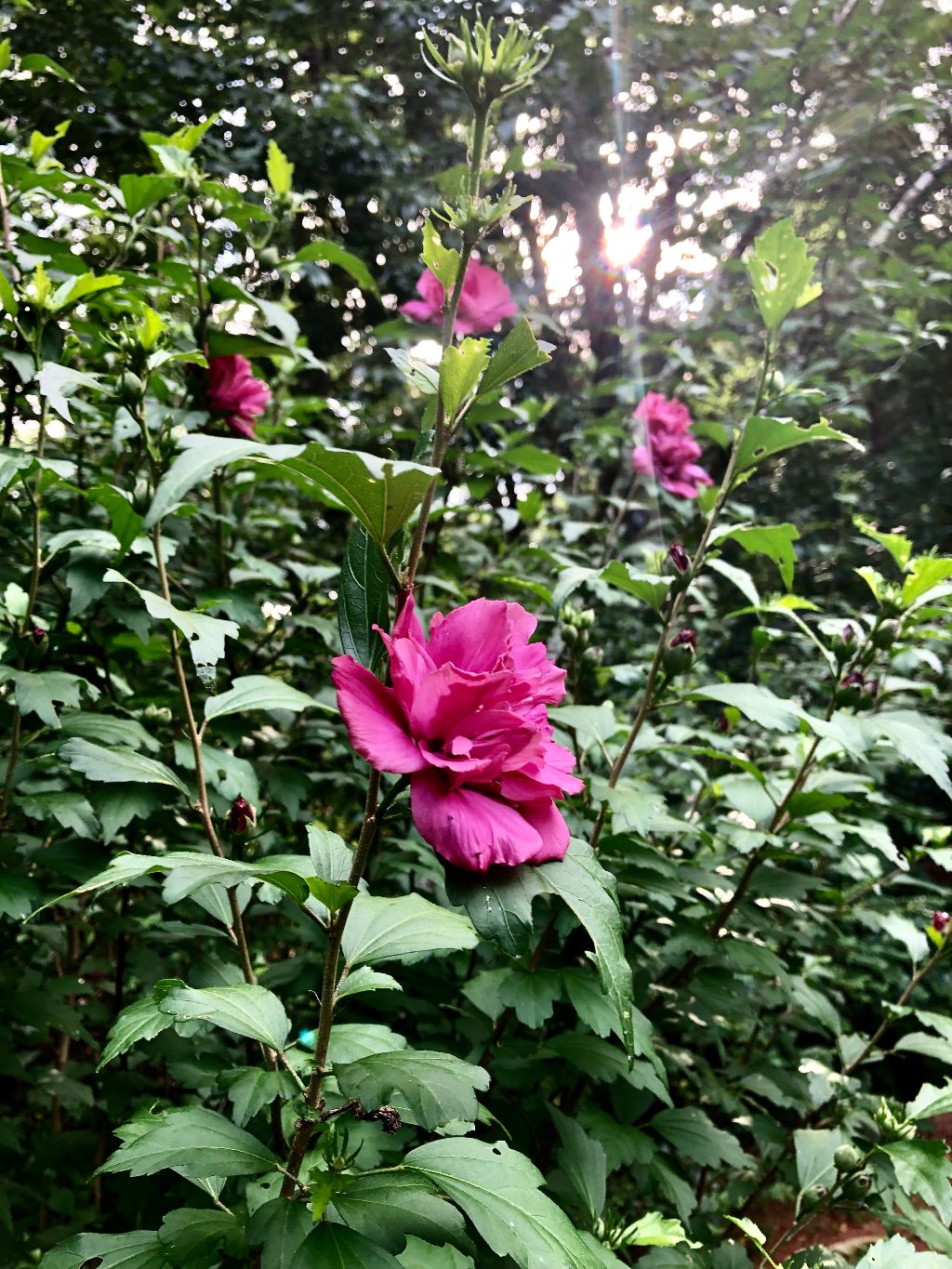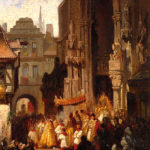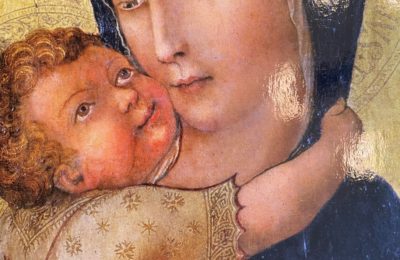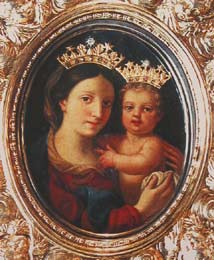“The rose,” Mary told Saint Brigid, “gives a fragrant odor; it is beautiful to the sight, and tender to the touch, and yet it grows among thorns, inimical to the beauty and tenderness. So may also those who are mild, patient, beautiful in virtue, be put to a test among adversaries. And as the thorn, on the other hand, guards, so do wicked surroundings protect the just against sin by demonstrating to them the destructiveness of sin.” Saint Brigid says: “The Virgin may suitably be called a blooming rose. Just as the gentle rose is placed among thorns, So this gentle Virgin was surrounded by sorrow.”
Roman Catholics view the world as a reflection of God: and, as such, flowers are often named after the Blessed Virgin Mary. The rose refers to her, the Mystical Rose, as does the Rose of Sharon. Yesterday, on a plot of land, in the shadows of the Blue Ridge Mountains, one K. Anne did see the first bloom on her thriving Rose of Sharon tree. It was a happy moment, and was captured in the above image. The blossom speaks to the heart of the beauty of that Singular Fair Maiden Mother and Queen; and reminds the inhabitants of that plot of land, of She who dwells in the Kingdom of her Son. For the topic of today’s post, I am delving a bit into the history of naming flowers after the Blessed Virgin Mary. John Horvat II wrote an article on this topic titled, The Marvelous World of Our Lady’s Flowers, where he stated:
While modern men look for happiness in instant gratification, there was once a time in Christendom when men believed happiness came from a true understanding of the order of the universe. They saw the universe as a great lesson book which, through symbols, one could come to know, love and serve God. One beautiful and touching page in this book was their perception of flowers.
With great practical sense born of observation, people of those distant times believed flowers to be symbolic of virtues and qualities that ultimately reflected the perfections of God, but which could be seen more directly in that most perfect of all God’s creatures – the Blessed Virgin.
Flowers belonged to Mary, the Mother of God. In those times when spiritual life and daily life were so intertwined, flowers were a veritable catechism for the faithful. Flowers transformed abstract virtues into easily understood symbols found in daily life and linked them to Our Lady, the perfect human model of Christian virtue.
Thus, there were at least a thousand flowers and herbs named after Our Lady, her qualities, and episodes in her life. In medieval times, each country circulated its own names and legends adapting to the local culture and flora. Art, poetry and literature celebrated this intimate link between flowers and the Blessed Mother. To better contemplate these marvels, there were enclosed “Mary Gardens” with those flowers and herbs that spoke of her to the faithful.
Some of the flower names make this link easy to trace. The marigold comes from the idea that this bright yellow flower is “Mary’s gold.” Carnation is a corruption of the word “coronation” since the flower was often used to crown statues of Our Lady. The herb Rosemary is said to honor Mary, the Mystical Rose. “Lady’s Slipper,” like many other flowers that now begin with the word “lady,” was originally “Our Lady’s Slipper.”
However, other flower names have not survived to our times. The lily of the valley was called Our Lady’s Tears, since from afar the white flowers seemed like tear drops falling. The humble sweet violet used to be known as “Our Lady’s Modesty.” The enchanting forget-me-nots were reminders of the “Eyes of Mary.” Even the lowly dandelion with its bitter tasting greens came to be called “Mary’s Bitter Sorrow.” And the names go on and on, since nearly every familiar flower or herb known today had its equivalent Marian name.
Some flowers gained their name because they bloomed close to feast days. The snowdrop, for example, was called “Candlemas Bells” since it often bloomed early on Candlemas – the feast of the Purification. The Assumption lily bloomed near the feast of the Assumption. It represented her immaculate purity, virginity and innocence that were rewarded by her assumption into heaven.
Of course, the rose came to symbolize Mary from the earliest times of the Church since it is a flower so rich in expression that it encompassed her purity, sorrow and glory. Numerous varieties of rose are associated with the Blessed Mother: the Rose of Sharon, Christmas Rose, or Scotch Rose. A collection of roses in a garden was called a rosarium. Later, a collection of Hail Mary prayers became known as a rosary.
From this vision of flowers came lore and pious legend full of innocence and wonder. Legend has it, for example, that the tiny flower columbine sprang up wherever Our Lady’s foot touched the ground when on her way to visit her cousin Saint Elizabeth and was thus called “Our Lady’s Shoes.” It was said the carnation (also called “Mary’s Love of God”) first appeared when it sprang from the tears of the Blessed Mother that fell upon the ground upon seeing her Son carry the Cross.
The lily, it was said, was originally yellow and came from the sorrowful tears of Eve upon being expelled from paradise. When Our Lady stooped to pick a lily, the lily became white and fragrant. It is told that the stars of the heavens came down to earth in their desire to glorify the Christ Child in Bethlehem and planted themselves around the manger as radiant buttercups.
While such stories were but mere legend, they spoke of great truths. They served to enchant, instruct and inspire the faithful to greater devotion and love of God. They made more human that tender connection between the Blessed Mother and fallen humanity. In this way, common flowers united all in virtue, speaking through poetry and song to saint and sinner, rich and poor, old and young, learned and ignorant. (source)
And, Dr. Taylor Marshall published an article in June of 2012 which was titled, Why is Mary the Mystical Rose, where he stated that:
The Litany of Loretto invokes our Immaculate and Blessed Virgin Mary as the Rosa Mystica or “Mystical Rose.” What is meant by this phrase?
In the inspired Canticle of Canticles, the Holy Ghost refers to His bride as the “enclosed garden” of God. This image describes Mary’s virginity (“enclosed”) and that she herself is the new garden of Eden – the place where God Himself dwells.
The Canticle also says of her, “I am the Rose of Sharon, and the Lily of the valleys” (Cant. 2:1). The biblical “rose of sharon” is cultivated Asian shrub or small tree (Hibiscus syriacus) having showy bell-shaped rose, purple, or white flowers.
Saint Bernard of Clarivaux states that purple signifies humility and white signifies purity.
The most beautiful meditation on Our Lady as Rosa Mystica is found in the writings of Saint Brigid. “The rose,” Mary told Saint Brigid, “gives a fragrant odor; it is beautiful to the sight, and tender to the touch, and yet it grows among thorns, inimical to the beauty and tenderness. So may also those who are mild, patient, beautiful in virtue, be put to a test among adversaries. And as the thorn, on the other hand, guards, so do wicked surroundings protect the just against sin by demonstrating to them the destructiveness of sin.”
Saint Brigid says: “The Virgin may suitably be called a blooming rose. Just as the gentle rose is placed among thorns, So this gentle Virgin was surrounded by sorrow.” (source)
May Our Lady, the Mystical Rose, and the Rose of Sharon, pray for us!
~SCF






